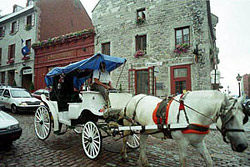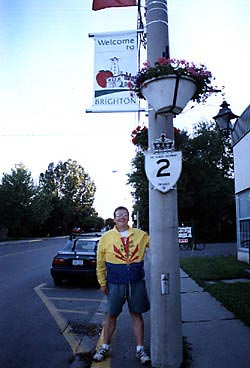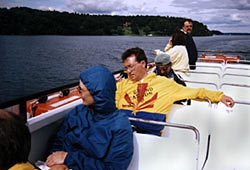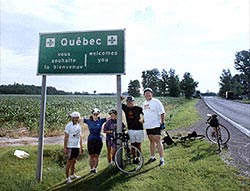
A carriage
makes its way through
the streets of Vieux Montreal.

Roger Kramer in Brighton, Ontario.
(Photo by Jack Lally)

Roger
catches a few winks during a cruise
of the Thousand Islands near
Kingston, Ontario.
(Photo by Ed Emond)

Sheep
graze along the St. Lawrence River
at Upper Canada Village.

BiQue
riders reach the Quebec-Ontario
border. Roger is at the right.
SUMMARY: I learned a lot of things on this ride from Toronto to Montreal. I learned how warm, charming and clean a big city can be, I learned how incredibly ignorant we Americans are of our northern neighbors, and I learned the proper usage of "eh" in a sentence. This is a good choice for someone doing a multiday bicycle ride for the first time. The terrain is mostly flat between Toronto and Montreal, and the prevailing wind is at your back. There are lots of historic landmarks along the ride, and Toronto and Montreal are first-class cities. Bud Jorgensen and his staff do an excellent job of organizing the trip, and the provided meals range from good to excellent!
RIDE WEB SITE:http://www.cyclecanada.com
BiQue Ride: 1997
After a brutal 1996, in which I did a hilly CAMP ride and the mountainous Grand Canyon to Arizona ride, I figured I was going to do easier rides in 1997.
1997 also happened to be the year when I discovered the Internet, and when I was seeking bicycle tours, I found the BiQue Ride. As a person who dealt with the humid summers of the St. Louis area most of my life, I always enjoyed going north on vacation to beat the heat. Besides, I had never been to Canada, and I figured I would get a lot from this ride.
I did. I found out that Toronto and Montreal are much cleaner cities than many other cities of similar size in North America. I learned that fireworks look different when seen from about a quarter-mile above the ground. I learned about how cosmopolitan Montreal really is. And, most importantly, I found out why Canadians say "eh?"
I flew into Toronto the day before the ride began, and I quickly wished I had flown in a day earlier. I would have liked to gone to the SkyDome to see the Toronto Blue Jays or simply walk through the pristine neighborhoods and bustling downtown. I was amazed how clean Toronto's subway system was. I became used to the graffiti that spoils the appearance of most U.S. mass transit systems, and I wondered to myself why can't we be more like Canadians.
Like a good tourist, I took the elevator to the top of the CN Tower and viewed the city's fireworks festival from above.
About 30 of us took off from Toronto's Old City Hall to the first destination, Bowmanville. Much of the ride was on Toronto's extensive bike path system, while the rest went through tedious suburbs. Things got more scenic between Bowmanville and Brighton as we passed through farmland and got views of Lake Ontario.
I am a native of Brighton, Ill., and it wasn't too surprising Brighton, Ontario, was a bit more of a vital town. We had an amazing meal at a bed and breakfast before the campers retired to Presque'ile Provincial Park, but not before Jack Lally took my picture in front of a Brighton sign.
That night, I talked with one of our tour support workers, Kristin, and being the ugly American, I told her, "You guys really do talk like Doug and Bob MacKenzie."
Kristin's reaction was a bit bemused, so I pressed on.
"What exactly does 'eh?' mean?"
Kristin resisted the temptation to slap me and kindly explained that Canadians add the term to turn a statement into a question, particularly when there's only one real answer that's correct. For example, if the temperature's 80°F, the sun's out and there's no clouds in the sky, a Canadian would say, "Beautiful day, eh?"
Of course it is, and there was only one right answer. A perfect time to use that word, eh?
Kristin and I talked a lot about our respective nations. I was disappointed to find out that folk-rock singer Bruce Cockburn is nearly as obscure in his native country as he is in the United States. Bruce is an artist who deserves a lot more recognition than what he gets.
On the next day, we crossed a canal and shortly encountered our one challenging hill for the week. We took a ferry from Picton for the final leg into Kingston. It was on that day that I gained a cycling partner for most of the rest of the trip. Jack Lally figured out that riding behind me would be beneficial to his cycling, since I'm big enough to block lots of wind. I didn't mind doing the work, because there wasn't that much work to do. The prevailing wind blows from Toronto to Montreal.
We stayed over a day in Kingston, the home of Fort Henry, the Canadian version of West Point. Kingston has a historic downtown district, and it is the point where Lake Ontario feeds the St. Lawrence River. It's also the start of the scenic Thousand Islands, so I decided to take a cruise. It was so relaxing that I fell asleep, and it was caught on film. I include it on this page as penance for asking Kristin about the use of the word "eh."
The next day took us to "beautiful downtown Brockville," as our other support worker, Tim, called it. Actually, it was a pretty average place. Tim was a lot of fun and led many of the rowdier cyclists on decadent evenings.
On Friday, we rode from Brockville to Summerstown. The ride also included time at Upper Canada Village, which consists of old buildings from throughout the St. Lawrence River valley that had to be removed when the St. Lawrence Seaway and its series of dams were built. At Summerstown, we took a boat to an island that is an Indian tribe's rustic resort. Lots of bottles of Canadian beer were consumed that night.
The final day brought us into Quebec. Even though the traffic signs changed from English to French, it was pretty easy to understand that "ARRET" means the same thing as "STOP." I ended up cycling with an Ontario couple, and we somehow managed to miss the delicious bakery on the route before crossing the bridges that would bring us to the Island of Montreal.
I was surprised to find the community of Beaconsfield, in which there was almost no French signage at all. We ate lunch there and then completed the final leg of the journey along the Canal de Lachine and its bicycle paths to Vieux Montreal, the city's old downtown.
Mainly because the residents of Montreal care about their French heritage, being in Montreal almost feels like being in Europe. Montreal is the world's second largest French-speaking city. We ended the trip with a banquet and a jaunt into the city's Latin Quarter with its bars and restaurants. Most of us headed back to Toronto on Sunday, but I stayed behind to see Montreal in more depth.
Despite my lack of knowledge of French, it was easy to navigate the city's Metro subway system. I used it to get to Olympic Stadium. I took the tour of the stadium, but I couldn't quite afford the trip up the tower. While it is a work of art from the outside, it's easy to see why the Expos would havedr to be in a more intimate stadium. That's one of several reasons why the team isn't in Montreal any more.
Finally, it was time to go home. At Montreal's Dorval Airport, a security man running the X-ray machine noticed my pedals.
"So what kind of bike do you ride?" the man asked. After telling him it was a Cannondale R500, we talked about cycling in Montreal and about my trip.
I had a similar reaction at the Toronto airport, where I went through U.S. Customs before the flight back to St. Louis.
By contrast, the reaction from the security woman in St. Louis at the start of the trip was considerably less friendly.
"I'm going to have to search your bag," she said. "What exactly are these things?" I told her they were bicycle pedals, and she only grudgingly believed.
We could learn a few things from our Canadian brethren, eh?